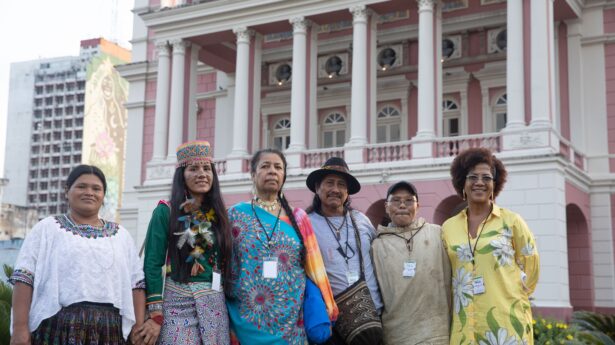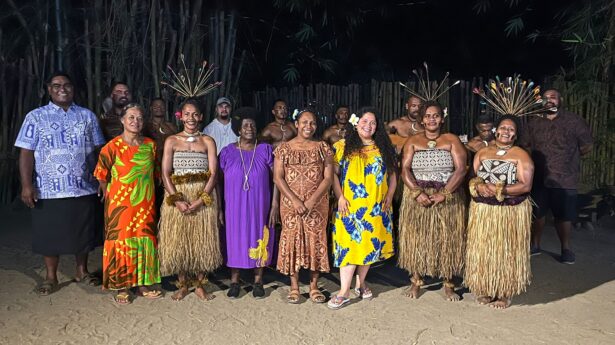The Unitarian Universalist Service Committee advances human rights through grassroots collaborations.
Indigenous Sovereignty is a Climate Solution

By Josh Leach on June 24, 2024
Over the past two centuries, European and European-descended colonial societies (like the United States) have glutted the world’s atmosphere with carbon fumes, leading to runaway heating that is impacting billions of people. This situation is one that few can now deny (especially this summer—when spiking temperatures are already causing floods, wildfires, and deadly extreme heat around the globe). But there remains widespread disagreement over what to do about it.
As intractable as the climate crisis now seems, however, there could be an elegantly simple solution. If colonial industrial societies have wreaked havoc through their theft of the world’s land, then perhaps it is time to reverse course: returning stewardship of the world’s resources to its pre-colonial inhabitants.
“A title which the courts of the conqueror cannot deny”?
For a long time, such calls to return the land to the United States’ Native peoples were dismissed as a pipe dream. Many European-descendent Americans today acknowledge the injustice of colonial powers’ original conquest of North America. But all too often, they regard this event as a fait accompli—i.e., as something that happened irrevocably in the past and cannot now be undone.
As far back as 1823, in one of the first major opinions from the U.S. Supreme Court dealing with Native land rights, Chief Justice John Marshall acknowledged that people might question the “original justice” of the European powers’ theft of the Americas. Nevertheless, he said, now that this wrongful appropriation of the land had been accomplished, it could not be reversed. As he put it, in one notorious line: “Conquest gives a title which the courts of the conqueror cannot deny[.]”
Few white Anglo-Americans today would feel comfortable endorsing Marshall’s choice of words. But his ruling doubtless reflects a widespread attitude among many descendents of Europeans living in the United States: The original theft of the land of this continent may have been wrong and indefensible—but what are we supposed to do about it now?
Yet, “Land Back” is already happening
Recent events prove, however, that returning the land to its original inhabitants is far from impossible. Over the past several years, the state of California—in partial recognition of its genocidal treatment of Indigenous peoples in the past—has made an effort to transfer some public lands to their original stewards. A story in the New York Times details these efforts, as well as related efforts by private landowners to convey their property to Indigenous groups at sub-market rates.
As welcome as these efforts doubtless are, however, the story also underlines some of the ironies and moral ambiguities of the “Land Back” movement. After all, what does it mean to “give back” (or sell at a discounted rate) land that was stolen in the first place?
Even more relevant to the problem of climate change: What is the quality of the land that the descendents of European settlers are now “returning” to its original inhabitants? As a result of resource depletion and climate destruction, after all, parts of the continental United States are swiftly becoming uninhabitable. The land may be changing hands, then, only after it has already been rendered worthless.
The Campsite Rule
As the New York Times story reveals, land in California is being “returned” to its Native inhabitants in a far worse condition than it was seized. The Owens Valley in California was once a verdant land fed by copious water from the nearby Sierra Nevada mountains. In order to gain the benefits of these natural resources, California officials redirected its waters toward the city of Los Angeles, through a massive 226-mile-long aqueduct.
This engineering feat helped the city develop into the sprawling metropolis it is today; but it also severely depleted the resources of the valley, leading to a downward spiral that has left the region’s ecosystem—as the article summarizes—“barely hanging on.”
We see the same problem throughout the Americas. Even where Indigenous peoples own their land outright, the resources and arability of that land are being steadily depleted by climate change. UUSC’s partners in Louisiana and Alaska, for instance, retain land rights to their territory, but at the same time—these ancestral lands are becoming unlivable due to climate destruction.
What good is “Land Back,” then, if the land that is returned has been destroyed in the meantime? A colleague of mine invokes the “campsite rule”: even if people leave the site on time, they ought to leave it in as good or better condition than they found it. A “gift” of terrain that has been depleted and ruined, by contrast, is no gift at all.
“Land Back,” then, is only part of the solution. In addition to restoring Indigenous land rights, powerful governments around the world—including the United States—also need to stop fueling the climate crisis that is rendering these lands uninhabitable.
A climate solution in plain sight
Fortunately, these two goals go hand-in-hand. Multiple studies have shown that restoring and protecting Indigenous land rights also serves the goals of climate justice. Statistically, Indigenous people on average take better care of the Earth’s resources. There is no mystery as to why this would be the case: Many Indigenous communities around the globe survive through a sustainable subsistence lifestyle based on the land’s natural abundance. Through millennia of traditional knowledge, they have learned to steward and safeguard these resources for future generations, instead of squandering them.
Placing stewardship in the hands of Indigenous peoples also helps guard against false climate solutions—such as “carbon offset” schemes, which effectively enable corporations to purchase a license to pollute in exchange for nominally “conserving” land elsewhere. In practice, much of the land “protected” through such schemes is actually not conserved at all, but rather is wrested from its original inhabitants by corrupt officials.
The climate crisis, then—no matter how vast and intractable it may seem—actually may have a simple solution. At the very least, we can make progress toward addressing it through means that are well within humanity’s hands. Returning the land to its original inhabitants and upholding existing Indigenous land and treaty rights not only helps to right a historic wrong—it also slows the ecological destruction that is making so much of this land uninhabitable.
UUSC is working to advance Indigenous sovereignty as a climate solution throughout North America and the Pacific Islands. You can learn more about our grassroots partners and our work on this critical issue by signing up for our email list here. You can also make a donation to support our efforts. A contribution in any amount helps us backstop our partners’ efforts to promote climate justice and Indigenous rights around the globe.
Image credit: Shutterstock (Wandering views)

